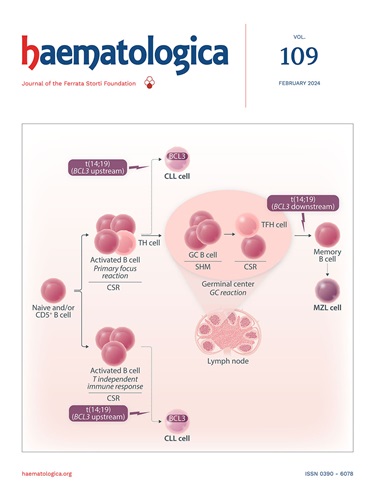Splenic erythrophagocytosis is regulated by ALX/FPR2 signaling.
IF 7.9
1区 医学
Q1 HEMATOLOGY
引用次数: 0
Abstract
Maintaining a healthy pool of circulating red blood cells (RBCs) is essential for adequate perfusion, as even minor changes in the population can impair oxygen delivery, resulting in serious health complications including tissue ischemia and organ dysfunction. This responsibility largely falls to specialized macrophages in the spleen, known as red pulp macrophages, which efficiently take up and recycle damaged RBCs. However, questions remain regarding how these macrophages are acutely activated to accommodate increased demand. Proresolving lipid mediators stimulate macrophage phagocytosis and efferocytosis but their role in erythrophagocytosis has only recently been described. To investigate the role of lipid mediators on red pulp macrophage function, we targeted the ALX/FPR2 signaling pathway, as this receptor binds multiple lipid mediator ligands eliciting potent macrophage responses. We found that mice with Fpr2 deletion exhibited disrupted erythrocyte homeostasis resulting in an aged RBC pool, decreased markers of splenic RBC turnover, and altered splenic macrophage phenotype characterized by changes in heme metabolism. Upon activation of ondemand erythrophagocytosis, production of the ALX/FPR2 ligand, lipoxin A4 (LXA4), was induced in the spleen while receptor-deficient animals were unable to efficiently clear damaged RBCs, a defect that was conserved in mice with myeloid-specific FPR2 deletion. Similarly, mice lacking the LXA4 biosynthetic enzyme displayed defective erythrophagocytosis that was rescued with LXA4 administration. These results indicate that the ALX/FPR2 signaling axis is necessary for maintenance of RBC homeostasis and LXA4 activation is a critical aspect of the red pulp macrophage response to acute erythroid stress.脾红细胞吞噬是由ALX/FPR2信号调控的。
维持健康的循环红细胞(rbc)对于充分的灌注至关重要,因为即使是微小的变化也会损害氧气输送,导致严重的健康并发症,包括组织缺血和器官功能障碍。这一责任主要落在脾脏的特化巨噬细胞上,即红髓巨噬细胞,它能有效地吸收和回收受损的红细胞。然而,关于这些巨噬细胞如何被急性激活以适应增加的需求,问题仍然存在。促溶脂质介质刺激巨噬细胞吞噬和efferocytosis,但其在红细胞吞噬中的作用直到最近才被描述。为了研究脂质介质在红髓巨噬细胞功能中的作用,我们以ALX/FPR2信号通路为目标,因为该受体结合多种脂质介质配体,引发有效的巨噬细胞反应。我们发现Fpr2缺失的小鼠表现出红细胞稳态破坏,导致红细胞池老化,脾脏红细胞周转标记物减少,脾脏巨噬细胞表型改变,其特征是血红素代谢改变。在按需红细胞吞噬激活后,在脾脏中诱导ALX/FPR2配体脂素A4 (LXA4)的产生,而受体缺乏的动物无法有效清除受损的红细胞,这一缺陷在骨髓特异性FPR2缺失的小鼠中是保守的。同样,缺乏LXA4生物合成酶的小鼠表现出红细胞吞噬功能缺陷,这种缺陷在给予LXA4后恢复。这些结果表明,ALX/FPR2信号轴对于维持红细胞稳态是必要的,LXA4激活是红髓巨噬细胞对急性红细胞应激反应的关键方面。
本文章由计算机程序翻译,如有差异,请以英文原文为准。
求助全文
约1分钟内获得全文
求助全文
来源期刊

Haematologica
医学-血液学
CiteScore
14.10
自引率
2.00%
发文量
349
审稿时长
3-6 weeks
期刊介绍:
Haematologica is a journal that publishes articles within the broad field of hematology. It reports on novel findings in basic, clinical, and translational research.
Scope:
The scope of the journal includes reporting novel research results that:
Have a significant impact on understanding normal hematology or the development of hematological diseases.
Are likely to bring important changes to the diagnosis or treatment of hematological diseases.
 求助内容:
求助内容: 应助结果提醒方式:
应助结果提醒方式:


